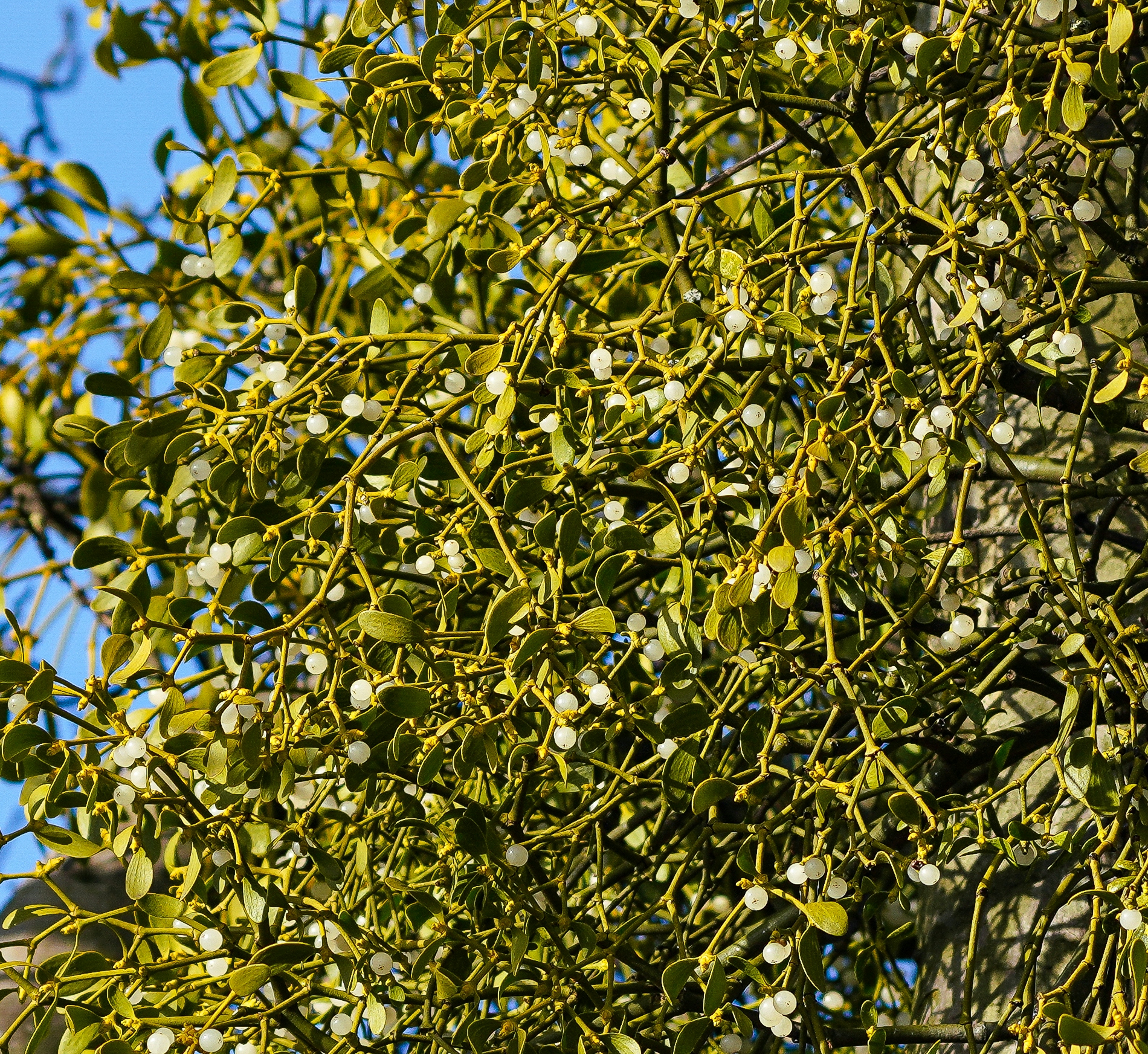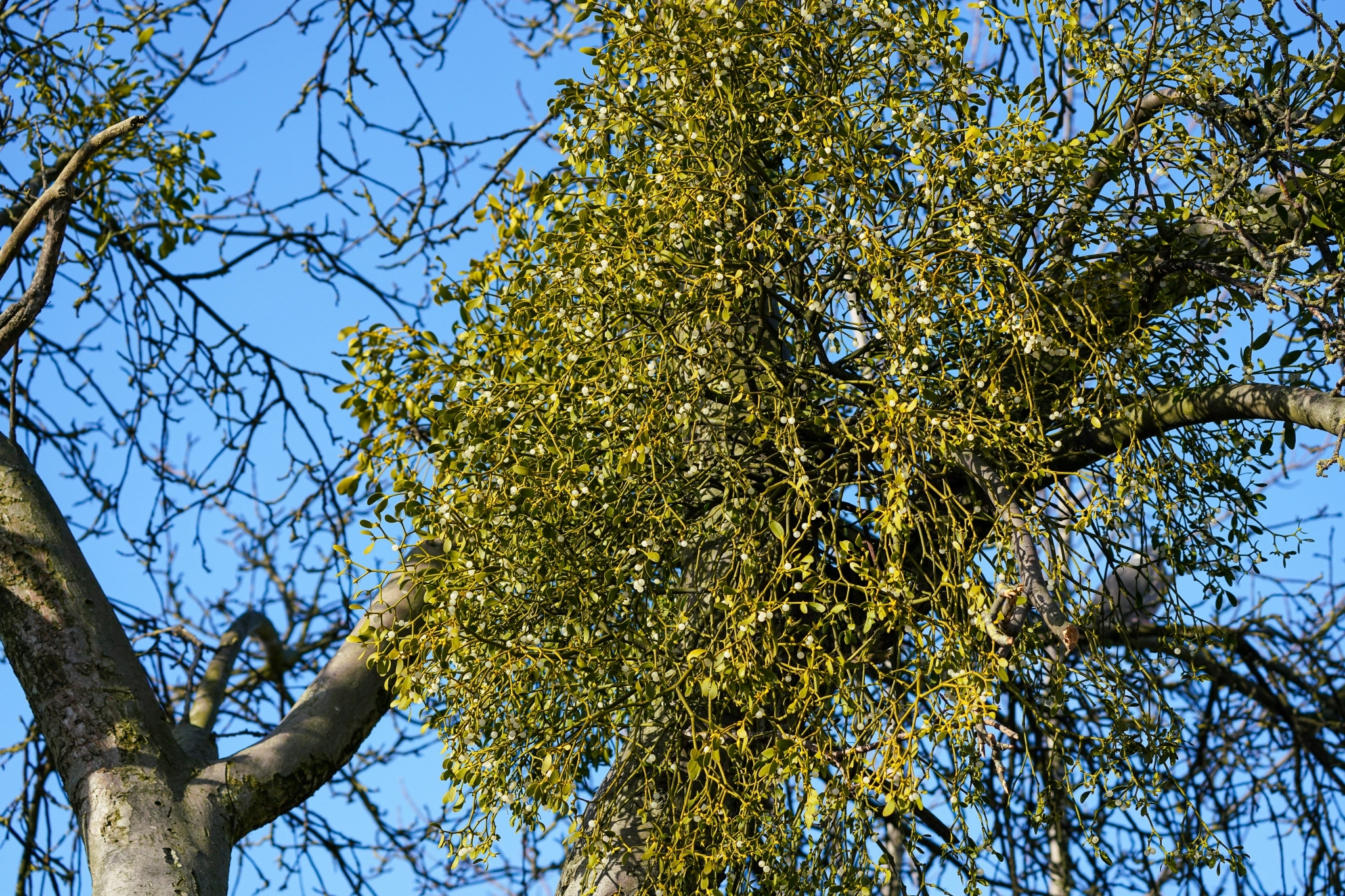HIGH FLIERS: MISTLETOE

Look up at the bare trees in winter and sooner or later you’ll see a round ball of Christmas romance standing out against the empty branches: mistletoe. The question is, how does it get so high?
WHERE TO SEE MISTLETOE (JUST LOOK UP!)
The main mistletoe hosts in the UK are apple, lime, hawthorn and poplar trees. Mistletoe doesn’t do very well within woodland, so you usually see it in more open areas. It’s particularly easy to see in the winter, and this is when it has berries, which is why it’s associated with Christmas. Because it doesn’t grow in canopy cover, mistletoe is easy to see when you’re out and about in suburbia. It’s common in gardens but also in lone trees on roadsides and in local parks, where trees tend to be quite spread out.
Mistletoes have males and females. Like willow trees, they are dioecious. The females have berries.
THE HIGH LIFE: HOW MISTLETOE STAYS SO FAR ABOVE THE GROUND
All plants have a strategy for how they spread their seeds. Dandelions and bullrushes disperse their seeds on the wind, euphorbia and lupins disperse their seeds by explosion, but mistletoe relies on feathered friends to spread its seed and make sure that it stays at its lofty heights.
The funny thing is, for a plant that relies on birds to eat its seeds, mistletoe hasn’t made its berries very attractive. For one thing, they’re white, and most British birds are looking for black, orange or blue berries. Worse, they’re sticky and difficult to eat, which narrows the number of birds willing to bother with them.
The main visitor to the mistletoe berry shop in the UK is the mistle thrush, but even they’re not particularly good at it. The seed is sticky because it’s designed to require the bird to wipe their break on a branch to remove the stickiness, spreading the seed onto a branch and sticking it in place so that it doesn’t drop to the ground. This complexity of design is entirely lost on the mistle thrush, though, which eats the berries whole and then poops them out in a long sticky trail that looks like a ropey pearl necklace (Chris Packham described it as ‘like art’ recently on Winter Watch, but I wouldn’t recommend watching this spectacle whilst eating).
So how does mistletoe spread, if its main customer doesn’t do its clever seed dispersal strategy justice? Well, some other birds like fieldfares and redwings will also eat mistletoe berries, but they’re not really big players in the mistletoe-seed-spreading game either. For a while, it was difficult for mistletoe to spread because of the unattractiveness of the seeds. Enter the star of the show stage left: the blackcap.
Blackcaps are small grey birds about the size of a great tit, predictably with a black cap on their head (although it’s light brown in females). As of fairly recently, they’re common winter visitors to the UK. Importantly for mistletoe, they don’t poop out the berries whole. They play the mistletoe game by the rules, eating the skin and flesh off of the berry and then wiping the seed off their beak on a nearby branch, thereby helping the mistletoe to establish in a new location.
MISTLETOE: A LIFE-SAPPING PARASITE?
Mistletoe, like all plants, needs water, food, and nutrients. How does it get these if it’s 15 ft above the ground I hear you ask?
Well, first up, we know that mistletoe isn’t a full life-sapping parasite that does nothing for itself and bums around in its host tree like a lazy teenager. It has green leaves, and this means it has chlorophyll, and chlorophyll is for photosynthesis. So it does make its own food from sunlight.
However, it clearly doesn’t have a root all the way down into the ground, so it is hemiparasitic. It takes water and nutrients from the host tree (just not food).
Mistletoe infiltrates its host (I imagine them in Stealth Mode during this stage, in a tiny black beanie) by growing a structure a bit like a root, that grows down into the branch. Research is continuing, but it’s thought that mistletoe uses digestive enzymes to help work its way in. Once it’s into the branch, the mistletoe’s stealth structure (it’s actually called a haustorium but I’m sticking with the secret mission storyline) makes its way through the interior of the branch towards the xylem. The xylem is what carries water and nutrients around the tree, so once the stealth structure is in here, it’s mission complete and the mistletoe has access to what it needs from the tree.
A SILENT KILLER?
Although lots of people seem to be quick to say that mistletoe is an undesirable parasite that will kill a tree, it really doesn’t make sense for mistletoe (or any hemiparasite or parasite that wants to stick around) to kill its host. If the tree dies, the mistletoe dies, so it’s never going to be part of the mistletoe’s strategy to kill the tree.
Having said that, mistletoe doesn’t have any control over where its seeds are spread. So, if the black caps are wiping their beaks very close to the existing mistletoe, you can end up with a tree that is over-laden with lots of mistletoe, and this can weaken the tree. This is fairly unusual – if you look around, most trees you see mistletoe in will only have one or two plants.
Usually, then, mistletoe is no problem for the tree.
WHY WE SHOULD LOVE MISTLETOE
You shouldn’t just love mistletoe because it gives you an excuse to kiss someone you fancy at Christmas. It’s also great for wildlife and biodiversity.
Mistletoes occur across the world, with more than 900 species worldwide. They exhibit huge variety, and most of them offer a lot of support for biodiversity. David Watson has made the case that mistletoe should be recognised as a keystone species – a species that defines an entire ecoyststem. Watson had good reason to make this bold claim – in one of his studies, removing 5,000 mistletoe plants in the Billabong Creek in Australia led to a 25% reduction in the birdlife at the mistletoe-less sites compared to comparable sites nearby that kept their mistletoe.
In the UK, mistletoe is home to several insects, such as the mistletoe marble moth, which overwinters in mistletoe and is a Priority Species here. Obviously, it feeds our mistle thrushes who give us beautiful, lilting song from the tops of trees even in bad weather. It feeds our blackcaps and some other birds, and its leaves dropping to the ground provide nutrients.
Next time you’re out and about, have a look for mistletoe and see if you can see any blackcaps having their sticky breakfast!

RESOURCES
Jonathan Briggs, mistletoe enthusiast, has a delightful website that collects facts and news about mistletoe: http://mistletoe.org.uk/homewp/index.php/host-trees/
On the mistletoe marble moth: https://www.woodlandtrust.org.uk/blog/2018/12/where-does-mistletoe-grow/
David Watson on mistletoe as a keystone species: https://www.annualreviews.org/doi/10.1146/annurev.ecolsys.32.081501.114024
For a great article with a more detailed analysis of the method of parasitism of mistletoe: https://www.smithsonianmag.com/science-nature/biology-mistletoe-180976601/
On mistletoe marble moths: https://butterfly-conservation.org/moths/mistletoe-marble
This website has some useful information about methods of seed dispersal: http://theseedsite.co.uk/dispersal.html
If you’d like to hear the mistle thrush’s beautiful, melancholy song, try Lucy Lapwing on Youtube: https://www.youtube.com/watch?v=Wj_GVrj-n2A
Share with your friends
Subscribe to learn more
Join me in exploring our natural world and cultural heritage as we learn how to protect and restore it. Get notified on my latest posts and a monthly newsletter on wider conversation topics for us to chat about.
Recent Posts
If you enjoyed this one, then you might like these too.